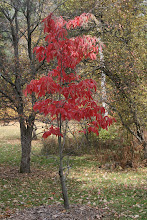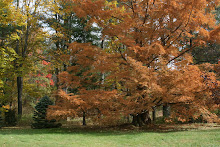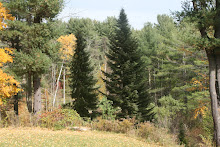Tuesday, October 30, 2012
HONEYLOCUST, BLACK LOCUST AND KENTUCKY COFFEETREE
THREE RELATIVES OF THE PEA FAMILY
Pine Hollow Arboretum Board member and accomplished area gardener Audrey Hawkins has contributed this article on her favorite tree, the Kentucky Coffeetree, and two of that tree's close relatives. All three species are included in Pine Hollow Arboretum's collection. Audrey says her favorite tree is the large Kentucky Coffee tree she has growing in her own yard.
Honeylocust (Gleditsia triacanthos), Black Locust (Robinia pseudoacacia) and Kentucky Coffeetree (Gymnocladus dioicus) are all in the Fabaceae Family
Bark of Kentucky Coffeetree
Bark of Black Locust
These three trees, native to the northeastern and mid-Atlantic United States have a lot in common but many ways to tell them apart. Being relatives of the pea family they all have seeds that are encased in a pod-like structure. The pods ripen and turn dark brown in October. Honeylocust has long narrow pods from 8 to 18 inches long and an inch wide that twist into irregular shapes. Kids like to use them as a rattle. The Kentucky Coffeetree has pods 5 to 10 inches long and 2 inches wide with a very leathery surface. Black Locust has a smooth flat pod that is 2 to 4 inches long.
All three trees have leaves that are either pinnately compound, bipinately compound or a mixture of both. All three have alternate leaf placement.(See below for illustrations of a compound leaf). The Honeylocust has both kinds of leaves. The bipinnate leaves on the Honeylocust are 6 to 8 inches long as are the pinnate leaves. The Kentucky Coffeetree has bipinnate leaves that are amazingly 36 inches long and 24 inches wide. The Black Locust has pinnate leaves that are 6 to 14 inches long. Both the Kentucky Coffeetree and the Black Locust have leaflets that are a deep shade of green with a blue tinge. The Honeylocust has much lighter hued green leaves that tend to drop off earlier in the fall season then the other two. All three have leaflets that are between 1 to 2 inches long and oval in shape. The Coffeetree has pointed leaflets.
Pinnately Compound Leaf from Kentucky Coffeetree (L) and Honeylocust(R)
One is most likely to see the Honeylocust tree because after the loss of many of our American Elm trees this tree was planted as a street tree. Many cultivars were developed which eliminated the prickles along the stem of the species and eliminated the pods. Unfortunately this tree has developed many diseases and insect problems that are exacerbated by planting many of the same kind of tree along an avenue instead of a diversity of species. The bark of a long established Honeylocust is rough and furrowed of a grey/brown color. The tree became especially popular with landscapers because it was easy to transplant and grew in many different kinds of situations. Also one can grow grass under this tree because it casts just a light shade.
Pinnately Compound Leaf from a Black Locust
The Black Locust is considered a weedy tree because it sprouts from the roots so you frequently see it growing in a grove. Because of this characteristic it is a good tree to plant on a slope that you are trying to stabilize or along highways and areas where tree cover would be an advantage. It’s not fussy about soil. Not good for a specimen tree on a lawn area for you will constantly be mowing down the sprouts. The bark of the mature tree forms long furrowed very deep ridges of a grayish color. It has prickles along the stems. There are numerous cultivars that have been developed mostly by European breeders that have mostly eliminated the prickles.
My real favorite is the Kentucky Coffeetree. The bipinnate leaves are so unusual being so large and the tree has a strange knobby look in the winter once the leaves have fallen. It has an interesting bark with scale like ridges but a beautiful pattern to the bark. It was once common in New York State and hopefully more will be planted for it has no diseases or insects of importance. It got its common name because when coffee was in short supply in Kentucky, the beans were roasted and made into a kind of coffee. It is said that the leaves and seeds are toxic to man and beast but roasting kills the toxins in the beans. There has been some progress made to develop cultivars. Also cloning only male trees so they do not have pods on them prevents a messy situation on a lawn. The species is a large tree, 75 feet at maturity so it would best be planted in parks or other large areas.
All three of these trees are hardy in Zone 4 to 8 since they are native to the Northeastern US.
---Audrey Hawkins
Pine Hollow Arboretum Board member and accomplished area gardener Audrey Hawkins has contributed this article on her favorite tree, the Kentucky Coffeetree, and two of that tree's close relatives. All three species are included in Pine Hollow Arboretum's collection. Audrey says her favorite tree is the large Kentucky Coffee tree she has growing in her own yard.
Honeylocust (Gleditsia triacanthos), Black Locust (Robinia pseudoacacia) and Kentucky Coffeetree (Gymnocladus dioicus) are all in the Fabaceae Family
Bark of Kentucky Coffeetree
Bark of Black Locust
These three trees, native to the northeastern and mid-Atlantic United States have a lot in common but many ways to tell them apart. Being relatives of the pea family they all have seeds that are encased in a pod-like structure. The pods ripen and turn dark brown in October. Honeylocust has long narrow pods from 8 to 18 inches long and an inch wide that twist into irregular shapes. Kids like to use them as a rattle. The Kentucky Coffeetree has pods 5 to 10 inches long and 2 inches wide with a very leathery surface. Black Locust has a smooth flat pod that is 2 to 4 inches long.
All three trees have leaves that are either pinnately compound, bipinately compound or a mixture of both. All three have alternate leaf placement.(See below for illustrations of a compound leaf). The Honeylocust has both kinds of leaves. The bipinnate leaves on the Honeylocust are 6 to 8 inches long as are the pinnate leaves. The Kentucky Coffeetree has bipinnate leaves that are amazingly 36 inches long and 24 inches wide. The Black Locust has pinnate leaves that are 6 to 14 inches long. Both the Kentucky Coffeetree and the Black Locust have leaflets that are a deep shade of green with a blue tinge. The Honeylocust has much lighter hued green leaves that tend to drop off earlier in the fall season then the other two. All three have leaflets that are between 1 to 2 inches long and oval in shape. The Coffeetree has pointed leaflets.
Pinnately Compound Leaf from Kentucky Coffeetree (L) and Honeylocust(R)
One is most likely to see the Honeylocust tree because after the loss of many of our American Elm trees this tree was planted as a street tree. Many cultivars were developed which eliminated the prickles along the stem of the species and eliminated the pods. Unfortunately this tree has developed many diseases and insect problems that are exacerbated by planting many of the same kind of tree along an avenue instead of a diversity of species. The bark of a long established Honeylocust is rough and furrowed of a grey/brown color. The tree became especially popular with landscapers because it was easy to transplant and grew in many different kinds of situations. Also one can grow grass under this tree because it casts just a light shade.
Pinnately Compound Leaf from a Black Locust
The Black Locust is considered a weedy tree because it sprouts from the roots so you frequently see it growing in a grove. Because of this characteristic it is a good tree to plant on a slope that you are trying to stabilize or along highways and areas where tree cover would be an advantage. It’s not fussy about soil. Not good for a specimen tree on a lawn area for you will constantly be mowing down the sprouts. The bark of the mature tree forms long furrowed very deep ridges of a grayish color. It has prickles along the stems. There are numerous cultivars that have been developed mostly by European breeders that have mostly eliminated the prickles.
My real favorite is the Kentucky Coffeetree. The bipinnate leaves are so unusual being so large and the tree has a strange knobby look in the winter once the leaves have fallen. It has an interesting bark with scale like ridges but a beautiful pattern to the bark. It was once common in New York State and hopefully more will be planted for it has no diseases or insects of importance. It got its common name because when coffee was in short supply in Kentucky, the beans were roasted and made into a kind of coffee. It is said that the leaves and seeds are toxic to man and beast but roasting kills the toxins in the beans. There has been some progress made to develop cultivars. Also cloning only male trees so they do not have pods on them prevents a messy situation on a lawn. The species is a large tree, 75 feet at maturity so it would best be planted in parks or other large areas.
All three of these trees are hardy in Zone 4 to 8 since they are native to the Northeastern US.
---Audrey Hawkins
Tuesday, October 2, 2012
INVITATION TO OUR FALL FESTIVAL
Fall Festival at Pine Hollow Arboretum
Please join us for a celebration of Fall!
Sunday, October 28, 2012
1:00 p.m. to 4:00 p.m.
At the Visitor's Center
(16 Maple Avenue, Slingerlands)
Activities Include:
Aborteum Tour led by John Abbuhl starting at 2:00 p.m.
Pumpkin Scavenger Hunt
Pumpkin Carving
Collage Making
Letterboxing for Families
30 Significant Trees Self-Tour
Final viewing of Art Show featuring 30 local artists.
Come and enjoy the season!
Sunday, October 28, 2012
1:00 p.m. to 4:00 p.m.
At the Visitor's Center
(16 Maple Avenue, Slingerlands)
Activities Include:
Aborteum Tour led by John Abbuhl starting at 2:00 p.m.
Pumpkin Scavenger Hunt
Pumpkin Carving
Collage Making
Letterboxing for Families
30 Significant Trees Self-Tour
Final viewing of Art Show featuring 30 local artists.
Come and enjoy the season!
Subscribe to:
Posts (Atom)















